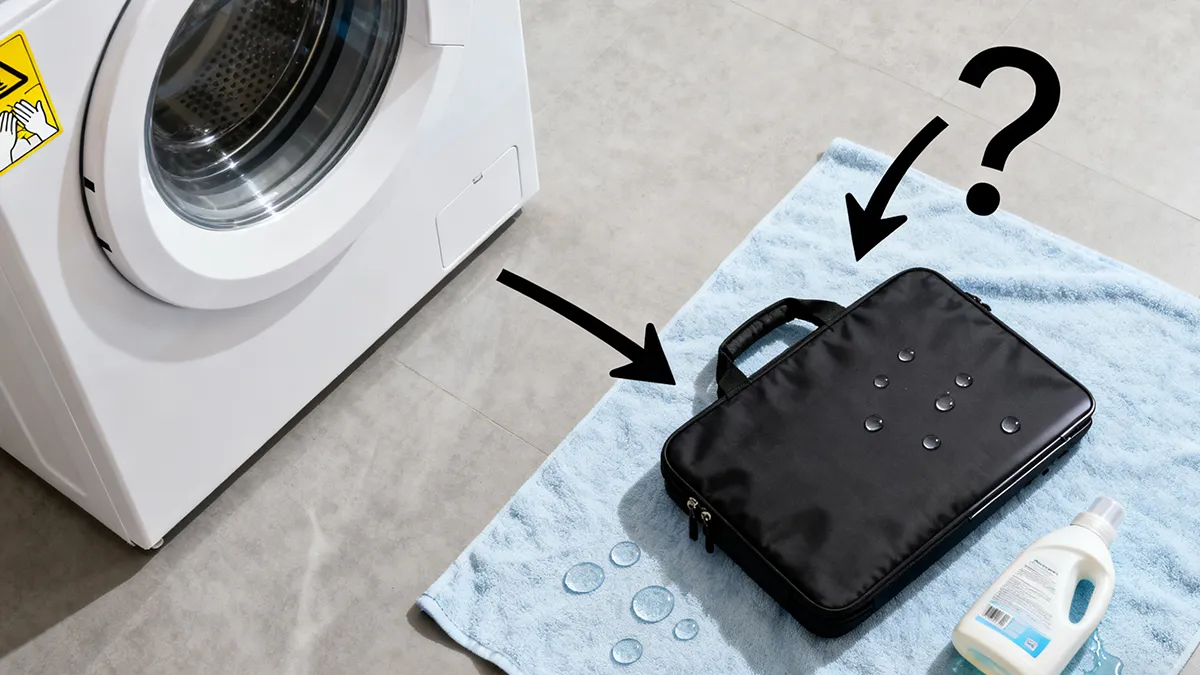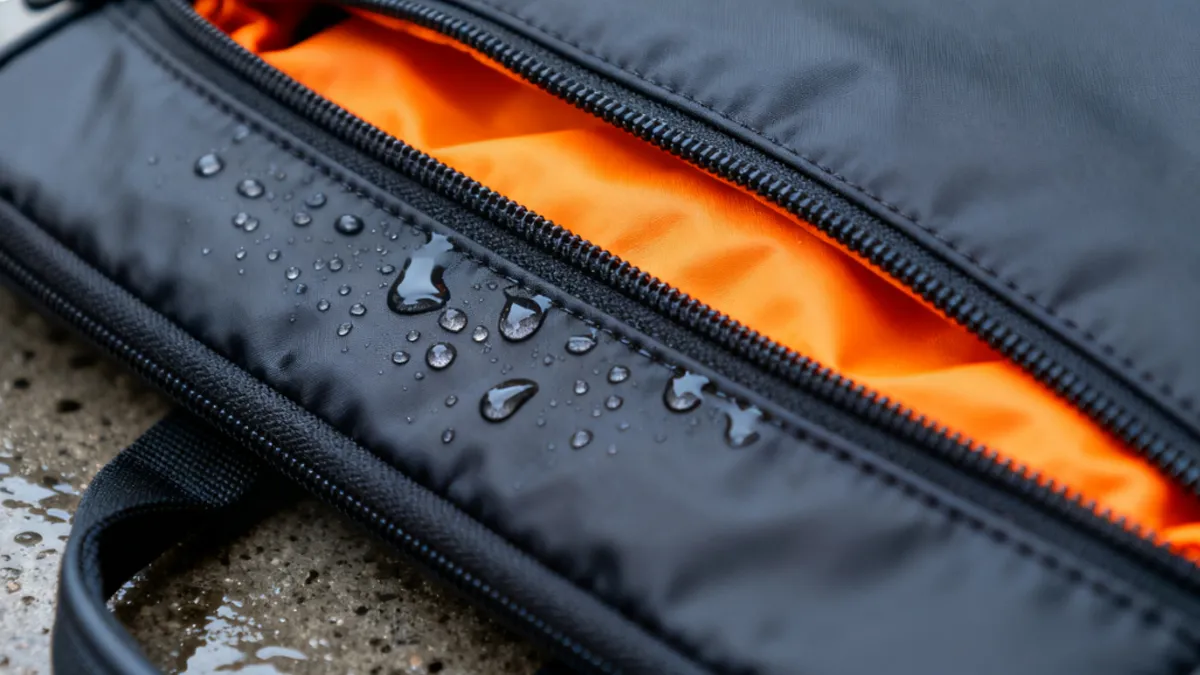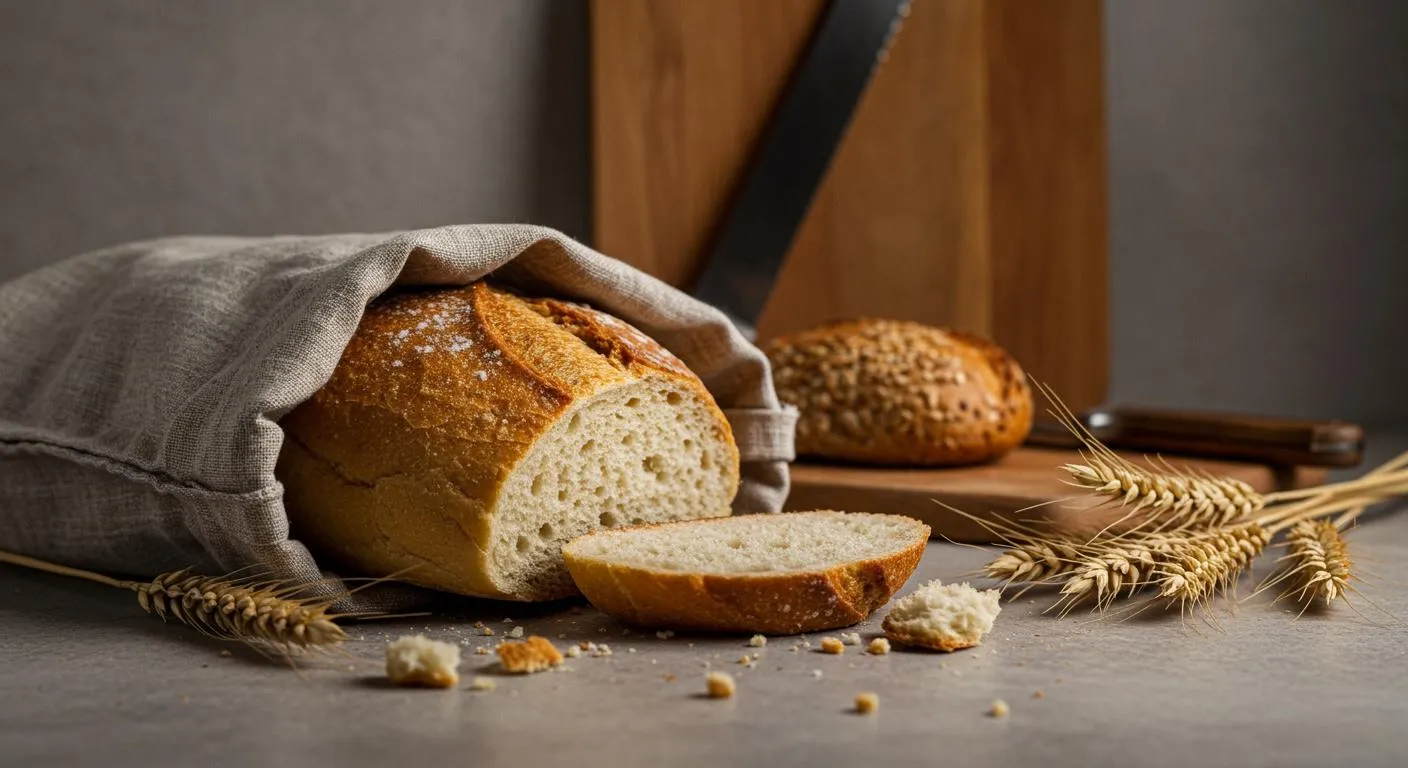
Do linen bags keep bread fresh? Yes, they do. You get balanced moisture, so your bread stays soft without turning soggy. Linen lets air move around, which means less mold and a healthier spot for your bread. You might notice that your bread feels fresher and tastes better. If you use plastic or paper, think about switching. You could see a big difference in how your bread lasts.
- Linen keeps moisture balanced
- Breathable fabric stops mold
- Natural antibacterial effect
Key Takeaways
- Linen bags keep bread moist but not wet.
- Linen lets air in and stops mold from growing.
- Linen kills some germs, so bread stays safe.
- Whole loaves stay fresh longer in linen bags than slices.
- Linen bags can be used again and help cut down on plastic.
- Clean linen bags often to keep bread fresh and stop smells.
- Linen bags are best for breads with hard crusts like sourdough. Soft breads may not work as well.
- If you want to keep bread for a long time, freeze it. Linen bags are good for keeping bread fresh for a short time.
Do Linen Bags Keep Bread Fresh
How Linen Bread Bags Work
Breathability
You might wonder, do linen bags keep bread fresh because of their breathability? The answer is yes. Linen lets air move in and out of the bag. This airflow stops moisture from building up inside. When you use a linen bread bag, you help your bread stay soft without getting soggy.
- Linen fabric allows air to flow, so your bread does not get too wet or too dry.
- The bag keeps the crust crisp and the inside tender.
- Compared to other materials, linen slows down mold growth and keeps bread fresh longer.
If you have ever used a plastic bag, you know bread can get mushy fast. Linen changes that. You get a better balance, and your bread tastes like it just came out of the oven.
Moisture Control
Do linen bags keep bread fresh by controlling moisture? Absolutely. Linen bread bags wick away extra moisture from the bread. This means your loaf does not sit in a damp environment.
- Unbleached linen bread bags pull moisture away, so your bread stays fresh.
- You avoid sogginess, which can ruin the texture and flavor.
- The bag keeps the right amount of moisture, so bread does not dry out too quickly.
You want your bread to stay soft inside but not sticky. Linen helps you find that sweet spot.
Antibacterial Properties
Do linen bags keep bread fresh because of their antibacterial properties? Yes, they do. Linen is a natural fiber with mild antibacterial effects.
- The fabric creates a less friendly place for mold and bacteria.
- Bread stays safe to eat for a longer time.
- You get peace of mind knowing your bread is in a clean environment.
When you use a linen bread bag, you help preserve bread and keep it tasting great.
Science Behind Bread Freshness
Let’s dig into why linen bread bags work so well. The science is simple. Bread needs airflow and balanced moisture to stay fresh. Linen bags give you both.
- Linen lets moisture escape, so mold does not grow as fast.
- The crust stays crunchy, and the inside stays soft.
- You avoid staleness because the bread does not dry out too quickly.
Compared to cotton bags, linen bread bags have better breathability. They slow down mold growth and keep bread fresher for longer. Cotton bags need extra airing, but linen does the job on its own. Tests show that linen bread bags help preserve bread better than other materials.
Tip: If you want to keep your bread fresh, use a linen bread bag. You get the best results when you store a whole loaf instead of slices.
Do linen bags keep bread fresh? Yes, they do. You get airflow, moisture control, and antibacterial protection. You help preserve bread and enjoy every bite. Linen bread bags make a big difference in how long your bread lasts and how good it tastes.
Linen Bread Bag vs Other Storage Methods
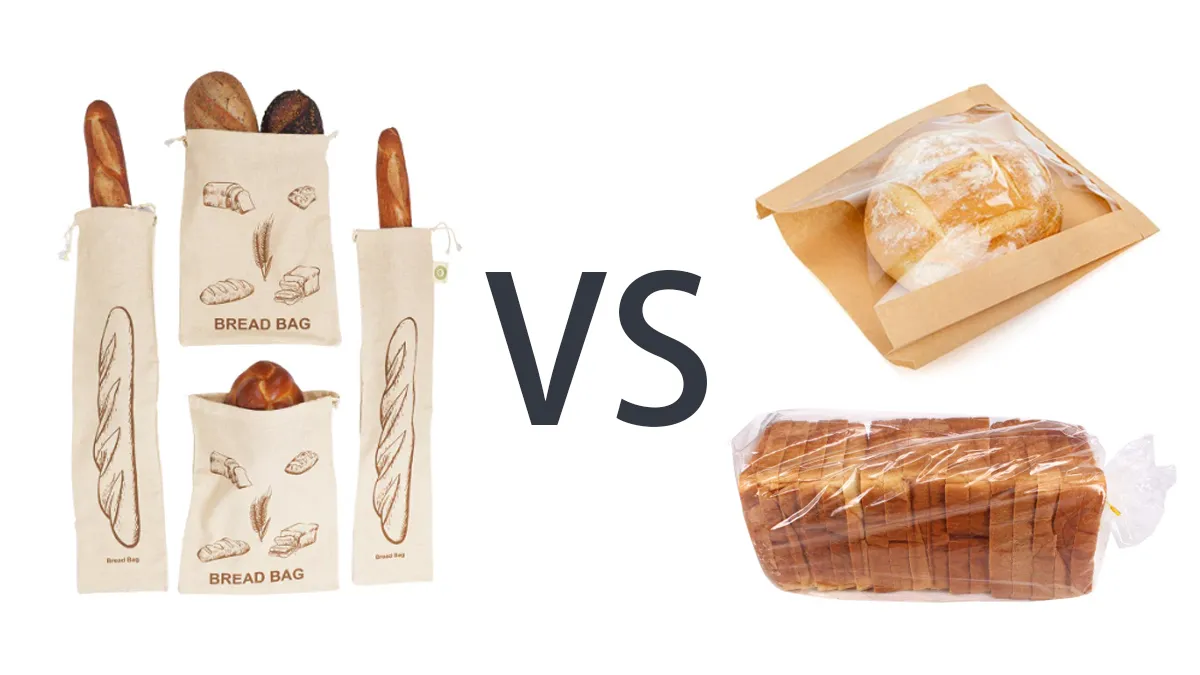
Plastic Bags
When you store homemade bread in a plastic bag, you might notice the crust turns soft and the bread gets soggy fast. Plastic traps all the moisture inside. This creates a perfect place for mold to grow. You may think your bread stays soft, but it often loses its fresh taste and texture.
- Bread in plastic bags molds quickly.
- The crust becomes spongy, not crisp.
- Plastic bags do not let bread breathe.
If you want to store homemade bread and keep it tasting great, a linen bread bag works much better. Linen lets air move around your bread. This keeps the crust crisp and the inside soft. You can expect your bread to stay fresh for up to five days in a linen bread bag. Plastic bags just cannot compete when it comes to freshness and flavor.
Tip: Linen bread bags cost more at first, but you save money over time because you can reuse them again and again.
Paper Bags
Paper bags offer a simple way to store homemade bread. They let some air in, so your bread does not get soggy. The crust stays crisp for a day or two. But paper bags dry out bread quickly. You might find your loaf turns hard after just one or two days.
- Paper bags help with crust texture.
- Bread dries out faster than in linen.
- Not reusable, so you throw them away after one use.
If you want to store homemade bread for more than a day or two, paper bags may not be the best choice. Linen bread bags do a better job of keeping bread soft inside while still letting the crust breathe.
Bread Boxes
Bread boxes give you another way to store homemade bread. They create a small space with just enough air to slow down drying. Bread boxes work well if you clean them often and keep them dry. Here’s a quick look at how bread boxes compare to cloth bread bags:
| Feature | Bread Box | Bread Bag (Cloth) |
|---|---|---|
| Moisture Retention | Good; keeps bread from drying out too fast. | Allows more moisture to escape; bread may dry out faster in dry climates. |
| Crust Crispness | Maintains crust with slight ventilation. | Keeps crust crisp in humid places; may harden in dry air. |
| Mold Prevention | Good if clean and dry; less airflow means less mold. | Breathable; less mold than plastic, but needs regular washing to stay fresh. |
You can use a bread box or a linen bread bag to store homemade bread. Both work well, but linen bread bags are easier to clean and reuse. They also help you avoid plastic waste, making them a smart choice for your kitchen.
Freezing
Freezing bread is a popular way to keep it fresh for a long time. If you bake bread in big batches or do not eat it quickly, you might want to try freezing. This method stops bread from going stale and keeps it safe from mold. You can freeze whole loaves or slices, so it fits your needs.
Let’s look at how freezing compares to storing bread in linen bags. Here is a quick table to show the difference in shelf life:
| Storage Method | Average Shelf Life |
|---|---|
| Linen Bread Bags | 3-4 days |
| Freezer | Significantly longer |
When you use a linen bread bag, your bread stays fresh for about three to four days. Freezing bread can keep it good for weeks or even months. That is a big difference! If you want to save bread for later, freezing is the best choice.
- Bread stored in linen bags lasts 3-4 days.
- Freezing bread can significantly extend its shelf life.
Freezing works by stopping the process that makes bread go stale. When you put bread in the freezer, you halt the retrogradation process. This means the bread does not lose moisture or get hard. You can take out a slice or a loaf whenever you want, and it will taste almost as fresh as the day you baked it.
But freezing bread has some downsides. The crust will not stay as crisp as when you use a linen bread bag. When you thaw frozen bread, the crust can turn soft or chewy. You might need to toast or bake it again to get that crunchy texture back. Also, freezing uses more energy than storing bread at room temperature.
If you care about sustainability, linen bread bags have an edge. You can reuse them many times, and they do not need electricity. Freezing bread means you use plastic wrap or freezer bags, which can create waste. Linen bags are better for the planet if you eat bread within a few days.
Here are some tips if you want to freeze bread:
- Slice your bread before freezing. You can grab just what you need.
- Wrap bread tightly to prevent freezer burn.
- Let bread thaw at room temperature for the best texture.
Note: Freezing is great for long-term storage, but linen bread bags are perfect for daily use. If you love fresh bread with a crisp crust, linen is your friend. If you want to save bread for weeks, freezing is the way to go.
Both methods have their place in your kitchen. You can use linen bread bags for everyday freshness and freeze extra bread to avoid waste. This way, you always have tasty bread ready when you want it.
Pros of Linen Bread Bags
Keep Bread Fresh Naturally
You want your bread to taste just as good on day three as it did when you first sliced it. Linen bread bags help you do that. They let your bread breathe, which means the crust stays crisp and the inside stays soft. Plastic bags can make bread tough and soggy, but linen gives you a natural way to keep bread fresh. You get the best of both worlds—no more chewy crusts or dry, crumbly slices.
Linen bread bags work for more than just bread. You can use them for fruits and vegetables, too. The fabric lets air move around, so your food stays fresh longer. You do not have to worry about your produce getting slimy or your bread losing its flavor. Linen bags help you keep bread fresh without any extra effort.
Tip: If you love homemade bread, try storing it in a linen bag. You will notice the difference in taste and texture right away.
Prevent Mold and Staleness
Nobody likes moldy bread. You want your bread to last, but you do not want it to get hard as a rock. Linen bread bags help you find that balance. They slow down mold growth by letting moisture escape. Your bread stays soft for a couple of days, and the crust keeps its crunch.
Here’s a quick look at how linen bread bags compare to other storage methods:
| Storage Method | Freshness Duration | Mold Presence | Notes |
|---|---|---|---|
| Linen Bread Bag | 2 days | None | Bread remained soft with a crusty crust. |
| 4 days | Hardness | Bread became hard enough to be a weapon. |
You can see that linen bread bags do a great job for short-term storage. Bread boxes work better if you need to store bread for longer. They seal out moisture and stop mold even more, but linen bags give you a simple, natural way to keep bread fresh for a few days.
- Bread boxes last longer than linen bags.
- Bread boxes seal out moisture and stop mold.
- Linen bags are best for daily use and quick storage.
Eco-Friendly Choice
You care about the planet, and linen bread bags help you make a difference. They break down much faster than plastic bags, which can stick around for hundreds of years. You can use linen bags over and over, so you make less waste.
- Linen bread bags are biodegradable.
- They use less energy and water to make than plastic bags.
- You can reuse them many times, so you throw away less.
When you choose linen, you help the environment and keep bread fresh at the same time. It is a small change, but it makes a big impact.
Maintain Crust Texture
You love that crunchy crust on fresh bread, right? Nothing beats the sound and feel of a crisp crust when you slice into a loaf. If you use a linen bread bag, you can keep that texture for days. Linen works like magic for artisan breads and homemade loaves. You get a crust that stays crispy and an inside that stays moist.
Plastic bags trap moisture. Your bread gets soft and loses its crunch. You might notice the crust turns chewy or soggy overnight. Linen bread bags change the game. The fabric lets your bread breathe. Moisture escapes, so the crust does not get mushy. You keep the texture you love.
Here’s why linen bread bags help you maintain crust texture:
- Linen is breathable. Air moves in and out, so your bread does not sweat inside the bag.
- The absorbent nature of linen pulls away extra moisture. Your crust stays crisp, and the inside stays soft.
- Linen’s antibacterial properties help prevent mold and bacteria. You get bread that tastes fresh and feels great.
- You do not need plastic bags. Linen keeps your bread from getting soggy, so you enjoy every bite.
Let’s look at a quick comparison:
| Storage Method | Crust Texture After 2 Days | Interior Texture | Overall Taste |
|---|---|---|---|
| Linen Bread Bag | Crispy | Moist | Fresh |
| Plastic Bag | Soggy | Too soft | Bland |
| Paper Bag | Hard | Dry | Stale |
You want your bread to taste like it just came out of the oven. Linen bread bags help you do that. You get a crispy crust and a moist interior. You do not have to worry about your bread turning hard or rubbery.
Tip: If you bake artisan bread, try storing it in a linen bread bag. You will notice the crust stays crunchy longer, and the flavor stays true.
You might wonder if linen works for all types of bread. It does a great job with sourdough, baguettes, and rustic loaves. You get the best results when you store whole loaves instead of slices. Linen helps you enjoy bread the way it was meant to be—crunchy on the outside, soft on the inside.
You do not need to fuss with complicated storage methods. Linen bread bags make it easy. You keep the crust texture you love, and you get to enjoy fresh bread every day. Give linen a try, and see how much better your bread tastes and feels.
Cons of Linen Bread Bags
Bread May Dry Out
You might love how linen bread bags keep mold away, but you could notice your bread dries out faster. Linen bags let air move freely. This helps moisture escape. Your bread loses water more quickly than in a plastic bag. Plastic traps moisture, so bread stays soft longer. Linen does the opposite. You get a crisp crust, but the inside can turn hard if you leave bread too long.
If you live in a dry climate, your bread may dry out even faster. You might slice into a loaf and find it feels tough or crumbly. Some people like a crunchy crust, but nobody wants bread that feels stale. You need to check your bread often. If you want to keep it soft, try storing whole loaves instead of slices. Sliced bread dries out much faster.
Tip: Wrap your bread in a clean towel before placing it in the linen bag. This helps slow down drying.
Here’s a quick look at how linen compares to other storage options:
| Storage Method | Moisture Retention | Drying Speed |
|---|---|---|
| Linen Bread Bag | Low | Fast |
| Plastic Bag | High | Slow |
| Bread Box | Medium | Moderate |
You get great airflow with linen, but you trade some moisture. If you want bread that stays soft for days, linen might not be your best choice.
Not for All Bread Types
Linen bread bags work best for crusty, artisan-style loaves. You get a crunchy crust and a soft inside. Some breads do not do well in linen bags. Soft sandwich bread, brioche, or rolls can dry out quickly. These breads need more moisture. Linen lets too much air in, so they lose their softness.
If you bake sweet breads or buns, you might want to use a different storage method. Plastic bags keep these breads moist and tender. You can use linen for sourdough, baguettes, or rustic loaves. You get the best results with whole, unsliced bread.
- Crusty breads: Great in linen bags
- Soft breads: Dry out quickly
- Sweet breads: Lose moisture fast
You need to match your bread type to your storage method. Linen is not a one-size-fits-all solution.
Cleaning Needed
You want your bread to stay fresh and safe. Linen bread bags need regular cleaning. Crumbs and moisture can build up inside the bag. This creates a spot for bacteria or mold. You should wash your linen bag every week. Use mild soap and warm water. Let it dry completely before using it again.
If you skip cleaning, your bread could pick up odors or taste strange. You might see spots or stains inside the bag. Linen is easy to wash, but you need to remember to do it. Clean bags help keep your bread tasting great.
Note: Always let your linen bread bag air dry in sunlight. Sunlight helps kill germs and keeps your bag fresh.
You get a reusable, eco-friendly bag, but you need to care for it. Regular cleaning keeps your bread safe and delicious.
Limited Odor Protection
You might love how linen bread bags keep your bread fresh, but they do not do much to block odors. Linen is a natural, breathable fabric. This means smells can pass through the bag pretty easily. If you store your bread near strong-smelling foods, your loaf can pick up those scents. Garlic, onions, or even ripe bananas can leave their mark. You may notice your bread tastes a little off or smells strange.
Let’s say you keep your bread on the counter next to a bowl of fruit. The linen bag will not stop the bread from absorbing the sweet or sour smells. If you put your bread in a pantry with spices or coffee, the bread can take on those aromas, too. You might not mind a hint of cinnamon, but garlic bread when you did not ask for it? Not so great.
Here are some things you might notice with linen bread bags:
- Bread can absorb strong kitchen odors.
- The bag itself may start to smell after a while.
- Flavors can mix if you reuse the same bag for different types of bread.
Tip: Store your linen bread bag in a clean, odor-free spot. Keep it away from foods with strong smells.
You might wonder if washing the bag helps. It does, but only for a while. Linen holds onto odors, especially if you do not wash it often. If you use the same bag for sourdough one week and cinnamon raisin the next, you could get a mix of flavors. That is not always pleasant.
Here’s a quick table to show how linen compares to other storage options for odor protection:
| Storage Method | Odor Protection | Notes |
|---|---|---|
| Linen Bread Bag | Low | Smells pass through easily |
| Plastic Bag | High | Seals in bread and blocks outside odors |
| Bread Box | Medium | Some protection, but not airtight |
If you want to keep your bread tasting just like it should, pay attention to where you store your linen bag. Do not put it near strong-smelling foods. Wash your bag often to keep it fresh. If you need to block odors completely, you might want to use a plastic bag or a bread box instead.
Linen bread bags do a great job at keeping bread fresh, but they cannot stop every smell. You get natural storage, but you trade off some odor protection. Choose what matters most to you—freshness, flavor, or a little bit of both.
How to Keep Bread Fresh Longer
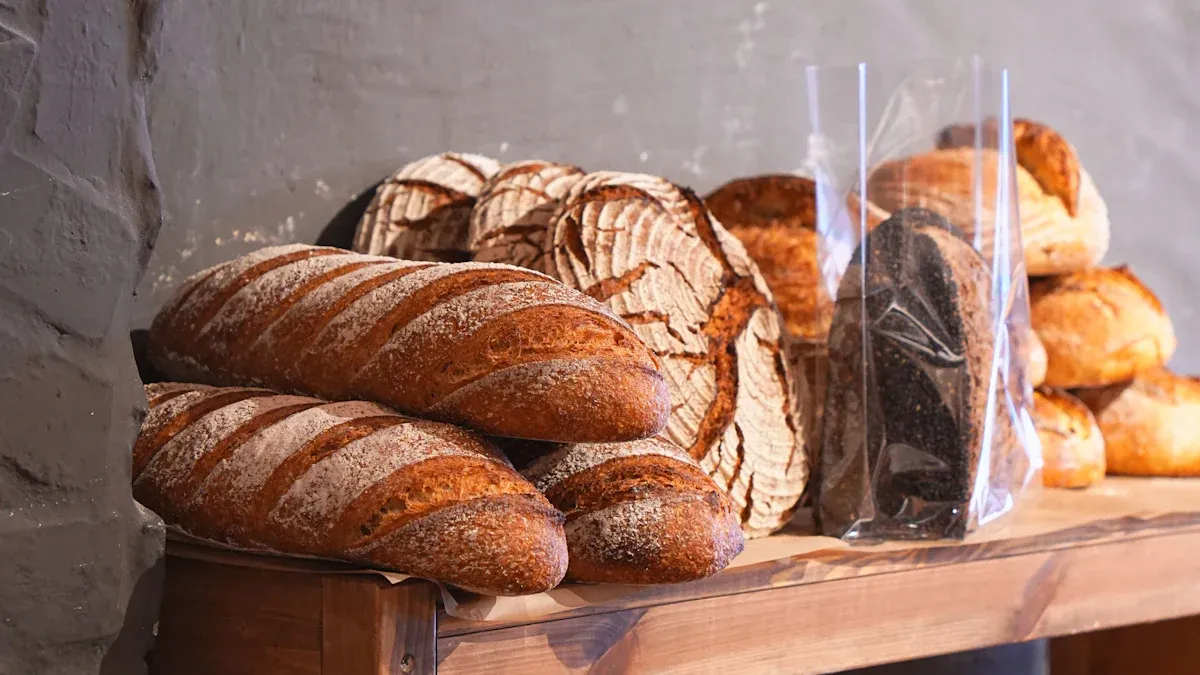
Using Linen Bread Bags
You want your bread to taste great for days, right? Linen bread bags help you do just that. If you want to know how to keep bread fresh longer, start with the way you use your bag.
Whole Loaf vs Sliced
Storing a whole loaf of bread in a linen bag keeps it fresh longer than sliced bread. When you slice bread, you expose more surface area to air. This makes it dry out faster. If you need to slice your bread, try cutting only what you plan to eat. Leave the rest of the loaf whole. You get a softer inside and a crisp crust for more days.
Tip: Slice bread as you need it. You keep the rest of your fresh loaf of bread safe from drying out.
Storage Location
Where you put your bread matters. Keep your linen bread bag in a cool, dry spot. Avoid direct sunlight and places near heat, like the stove. Humidity can make bread mold faster. A pantry or bread box works well. If you want to know how to keep bread fresh longer, pick a spot with steady temperature and low moisture.
Cleaning and Care Tips
You want your bread bag to stay clean. Wash your linen bread bag every week. Use mild soap and warm water. Let it air dry completely before you use it again. Sunlight helps kill germs and keeps your bag smelling fresh. If you skip cleaning, crumbs and moisture can build up. This can lead to mold or strange odors.
Here’s a simple cleaning routine:
- Shake out crumbs after each use.
- Wash with gentle soap once a week.
- Dry in sunlight or a well-ventilated area.
Note: A clean bag means safer bread and better taste.
Common Mistakes to Avoid
Many people make small mistakes when storing homemade bread. You can avoid these and keep your bread tasting great.
- Don’t store sliced bread in the bag for too long.
- Don’t put your bread bag near strong-smelling foods.
- Don’t forget to clean your bag often.
- Don’t use a damp bag. Always make sure it’s dry.
Here’s a quick table to help you spot and fix common mistakes:
| Mistake | What Happens | How to Fix |
|---|---|---|
| Storing sliced bread | Dries out quickly | Store whole loaf |
| Dirty bag | Mold or bad smells | Wash weekly |
| Damp storage spot | Faster mold growth | Use dry, cool location |
If you follow these tips, you’ll master how to keep bread fresh longer. Linen bread bags make storing homemade bread easy and natural. You get tasty bread every day with just a little care.
When to Use Linen Bread Bags
Best Bread Types
You might wonder which breads work best in linen bread bags. Crusty loaves like sourdough, baguettes, and rustic country bread stay fresh and tasty in linen. These breads have a thick crust that protects the soft inside. Linen helps keep the crust crisp and the crumb moist. If you bake artisan bread at home, you will love how linen keeps it from getting soggy or stale.
Soft sandwich bread, brioche, and rolls do not do as well in linen. These breads dry out faster because they have a thin crust. You may notice they lose their softness after a day or two. If you want to store sweet breads or buns, you might choose another method.
Here’s a quick table to help you decide:
| Bread Type | Linen Bag Performance | Notes |
|---|---|---|
| Sourdough | Excellent | Crust stays crisp |
| Baguette | Excellent | Soft inside, crunchy crust |
| Country Loaf | Excellent | Stays fresh for days |
| Sandwich Bread | Fair | Dries out quickly |
| Brioche | Poor | Loses moisture fast |
Tip: Store whole loaves in linen for the best results. Sliced bread dries out faster.
Ideal Situations
You want to use linen bread bags when you plan to eat bread within a few days. If you bake fresh bread often, linen is a great choice. You get a natural way to keep bread fresh without plastic or chemicals. Linen works well if you care about crust texture and flavor.
Here are some ideal situations for linen bread bags:
- You bake bread at home and eat it within three days.
- You want to avoid plastic waste.
- You love crusty bread and want to keep it crunchy.
- You store bread in a cool, dry kitchen.
If you have a busy household, linen bread bags make daily bread storage easy. You just pop the loaf in the bag and set it on the counter. You do not need to fuss with complicated containers.
Note: Linen bread bags are not airtight. You get better airflow, but bread may dry out faster in hot or dry climates.
Alternatives for Longer Storage
Sometimes you need to keep bread fresh for more than a few days. Linen bread bags work well for short-term storage, but you have other options for longer periods. Freezing is the best way to store bread if you want to save it for weeks. You can slice the loaf, wrap it tightly, and freeze it. When you need bread, just thaw a slice or two.
Plastic bags keep bread soft for longer, but they trap moisture and can cause mold. Bread boxes offer a middle ground. They slow down drying and keep bread fresh for up to a week. If you want to avoid waste, try freezing extra bread and using linen bags for daily use.
Here’s a quick list of alternatives:
- Freezing: Keeps bread fresh for weeks.
- Bread box: Good for up to a week.
- Plastic bag: Soft bread, but risk of mold.
- Paper bag: Short-term, dries out quickly.
Tip: Use linen bread bags for daily storage and freeze extra bread for later. You get fresh bread every day and avoid throwing away leftovers.
Real Experiences and Myths
Home Baker Stories
You might wonder how linen bread bags work in real kitchens. Many home bakers love them. You can find stories online where people share their results. Some say their sourdough stays fresh for three days. Others mention that baguettes keep their crunchy crust. One baker wrote, “I switched from plastic to linen, and my bread tastes better. The crust stays crisp, and I don’t see mold.”
Here are a few things home bakers notice:
- Bread does not get soggy.
- Crust stays crunchy.
- Bread dries out if you slice it too soon.
You may see bakers use linen bags for rustic loaves. They often say, “I just put my bread in the bag and leave it on the counter.” You do not need fancy tools. Linen bags make bread storage simple.
Tip: If you bake bread at home, try a linen bag for your next loaf. You might be surprised by the results.
Expert Opinions
Bread experts and chefs also share their thoughts. Many agree that linen bags help keep bread fresh. You can read interviews with bakers who say, “Linen lets bread breathe. It keeps the crust from getting soft.” Some experts recommend linen for sourdough and artisan bread.
Here’s what experts often mention:
- Linen controls moisture better than plastic.
- Bread boxes work well, but linen bags are easier to clean.
- Freezing is best for long-term storage.
You may see experts use linen bags in bakeries. They like the natural feel and the way linen protects bread. Some say, “Linen is the best choice for daily bread storage.”
| Storage Method | Expert Rating | Best For |
|---|---|---|
| Linen Bread Bag | ⭐⭐⭐⭐ | Artisan loaves |
| Plastic Bag | ⭐⭐ | Soft sandwich bread |
| Bread Box | ⭐⭐⭐ | Mixed bread types |
| Freezing | ⭐⭐⭐⭐ | Long-term storage |
Common Misconceptions
You might hear myths about linen bread bags. Some people think linen dries out bread too fast. Others believe linen cannot stop mold. Let’s clear up a few common misconceptions.
- Myth: Linen bags make bread stale overnight.
- Fact: Bread dries out faster if sliced, but whole loaves stay fresh for days.
- Myth: Linen bags do not protect against mold.
- Fact: Linen’s breathability slows mold growth compared to plastic.
- Myth: Only professionals use linen bags.
- Fact: Anyone can use linen bags at home.
Note: You do not need to be a baking expert to use linen bread bags. They work for anyone who wants fresh bread.
You may hear mixed opinions, but most people who try linen bags see better results. If you want to test the myths, try storing your next loaf in linen. You can see for yourself how well it works.
Conclusion
Linen bread bags help you keep bread fresh, tasty, and safe. You get crisp crusts, less mold, and a natural way to store homemade loaves. If you want better bread, try using linen bags and see the difference for yourself.
Ready to upgrade your bread storage? We make high-quality linen bags and offer custom OEM/ODM services. Reach out and discover how our products can fit your needs!
You have the power to enjoy fresher bread every day. Give linen a chance and share your results!
FAQ
How long does bread stay fresh in a linen bag?
You can expect your bread to stay fresh for about three to four days in a linen bag. The crust stays crisp, and the inside stays soft. For best results, store whole loaves.
Can I wash my linen bread bag in the washing machine?
Yes, you can wash your linen bread bag in the washing machine. Use mild soap and cold water. Let it air dry completely before using it again. This keeps your bag clean and fresh.
Do linen bread bags work for gluten-free bread?
Linen bread bags help gluten-free bread stay fresh, but these breads dry out faster. Store whole loaves, not slices. If you need to keep it longer, freezing works better.
Will my bread get moldy in a linen bag?
Linen bags slow down mold growth because they let air move around. Your bread is less likely to get moldy compared to plastic bags. Always use a clean, dry bag for best results.
Can I use a linen bread bag for store-bought bread?
You can use a linen bread bag for store-bought bread. Just remove any plastic packaging first. The bag helps keep the crust crisp and the bread tasting fresh.
What should I do if my bread dries out in a linen bag?
If your bread dries out, try wrapping it in a clean towel before placing it in the linen bag. You can also toast or warm the bread to bring back some softness.
Do linen bread bags come in different sizes?
Yes, linen bread bags come in many sizes. You can find small bags for rolls or large ones for big loaves. Pick a size that fits your favorite bread.
Can I store other foods in a linen bread bag?
You can use linen bread bags for fruits, vegetables, or even pastries. The breathable fabric helps keep many foods fresh. Just make sure to clean the bag between uses.

